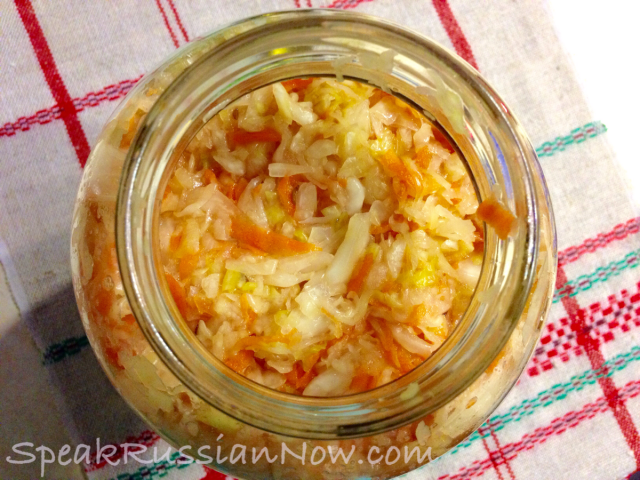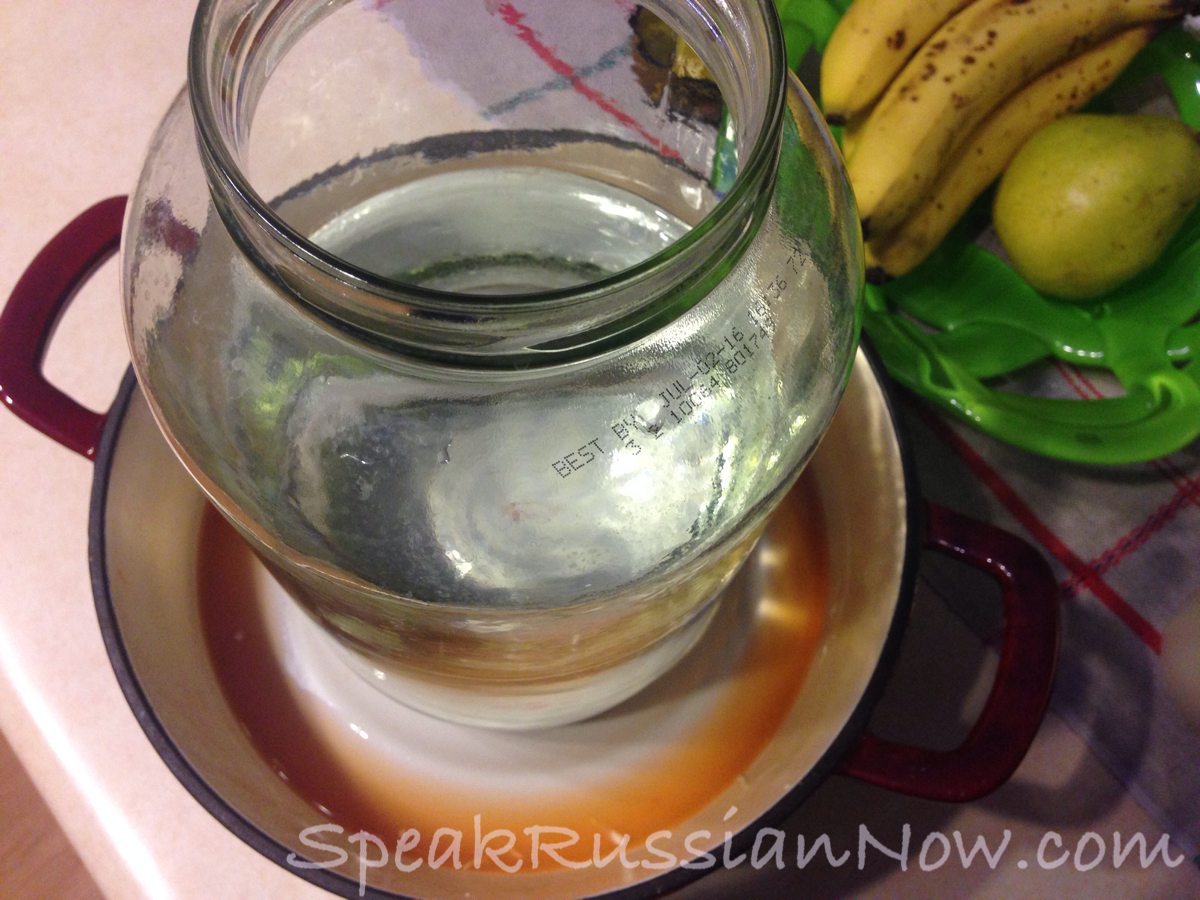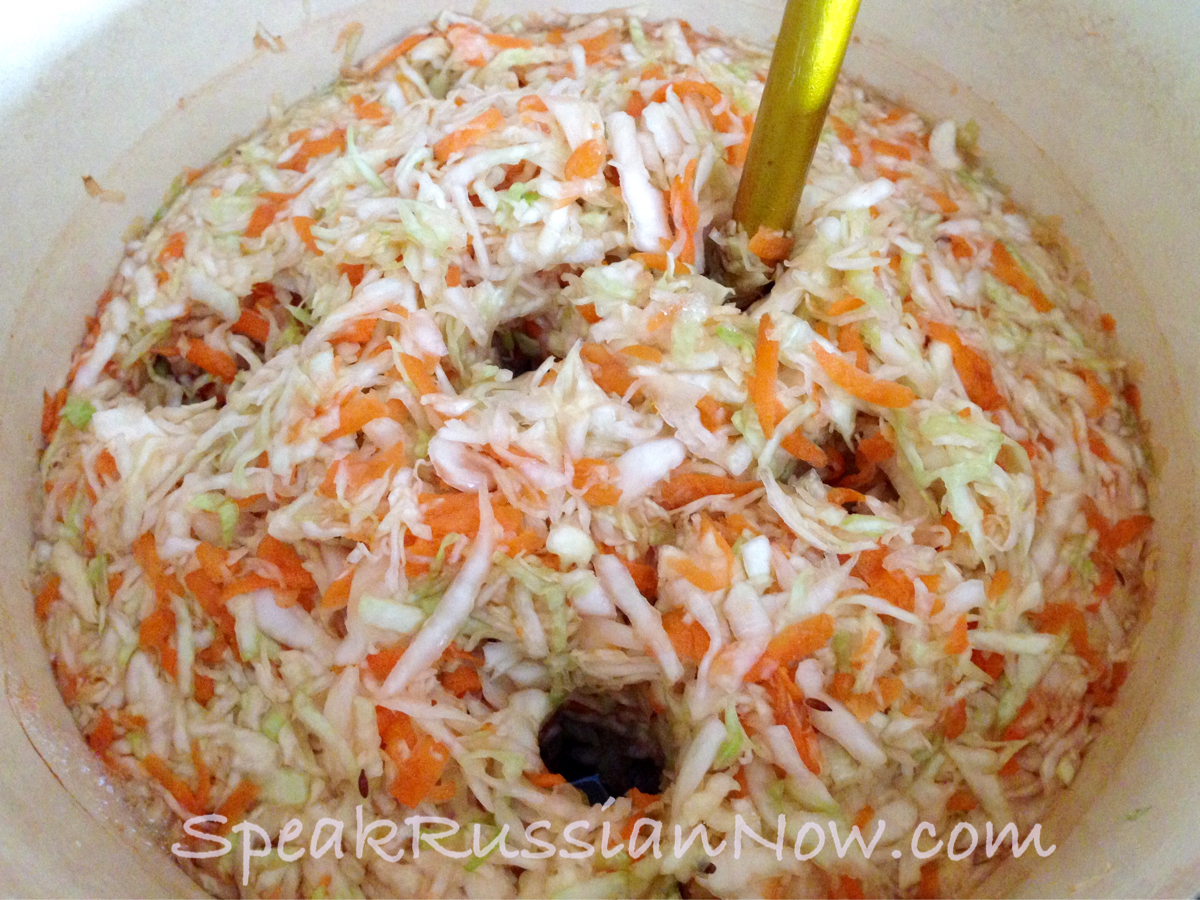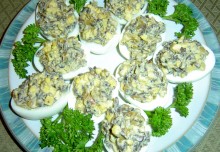
If you know anything about Russian culture, you know that Russians love to eat капу́сту [cabbage]. Coleslaw salads with mayo or подсо́лнечным ма́слом [sunflower oil] are often served in summer, and ква́шеная капу́ста [fermented cabbage] is a staple of Russian diet in winter. In this post, I am going to share with you our family реце́пт [recipe] ква́шеной капу́сты [for fermented cabbage]. You will need the following ingredients: – 2 kilos or 4.4 lbs (about 2 medium-sized heads) of green cabbage Step 1: This is the most important step because the quality of the cabbage you buy at the store will determine how good and crisp the fermented cabbage will be! Try picking cabbage heads that are tight and feel heavy for their size. The cabbage inner leaves should be white and crisp. Discard the outer few layers and wash the heads before preparing. Step 2: Cut each cabbage into quarters, then thinly slice each quarter into ribbons until all you have left is a cabbage core. There are different cabbage cutting techniques. This is how I do it: With my non-dominant hand, I hold the cabbage wedge core side up on the cutting board at a 60 degree angle. Then I start shaving the cabbage into thin ribbons with my chef’s knife maneuvering the wedge on the cutting board so that at the end all I have left is the core. Once you have sliced the cabbage, place it into a large bowl. Step 3: Wash and peel the carrots. Using a large-whole shredder, shred all carrots. Add the shredded carrots to the sliced cabbage. Step 4: Sprinkle the salt over the cabbage and carrots. Work the salt into the vegetables by massaging and squeezing the shredded cabbage and carrots with your hands. Continue mixing for 5-10 minutes until the cabbage starts giving out juices. Step 5: Once the cabbage, carrots, and salt are thoroughly mixed, add some caraway seeds. I add about half a teaspoon of caraway seeds for 2 kilos or 4.4 lbs of cabbage. You can adjust the seeds amount to your taste or leave them out entirely. Mix the cabbage one more time to make sure the caraway seeds are distributed evenly. Step 6: Place the cabbage into a large pot. Press it down firmly with your hands until it is submerged beneath its juices. Put a plate on top of the cabbage and press it down. If your cabbage doesn’t have enough juice, cover it with a cheesecloth before pressing it down with a plate to keep the cabbage at the top from drying. Step 7: Weigh down the cabbage by placing something heavy on top of the plate. I use a jar filled with water. Step 8: You may want to cover the pot with a towel secured with a large rubber band to prevent contamination from insects. Step 9: Allow the cabbage to ferment for 2-3 days in a cool place away from direct sunlight. The ideal temperature in the room should be 15 – 18 C or 60 – 65 F. The temperature in my kitchen was around 70 F during the day and 65 F at night. Step 10: As fermentation begins, carbon dioxide is released. In a couple of days, you should see bubbles coming up around the plate. Step 11: When the bubbles have come up to the top, remove the weight, the plate and the cheesecloth (if you used one), and let the gases out by puncturing the cabbage all the way down with a wooden stick or a clean finger. Step 12: Repeat Step 11 once or twice a day for the next 2-3 days until the bubbling has slowed. Step 13: This step is optional. Once you puncture the cabbage on the second or third day, add 2 tablespoons of sugar. Then place the weight back on top of the cabbage. Step 14: On day 4 or 5, taste the cabbage. If it tastes good to you, then it is ready for consumption. You can let the cabbage ferment for a few more days, if it doesn’t taste sour enough for you. When the fermented cabbage tastes to your liking, remove the weight, the plate, and the cheesecloth (if you used one). You can add 1/4 – 1/2 a cup of cold water, if the cabbage doesn’t have a lot of juice. Step 15: Take the fermented cabbage out and place it on a large cookie sheet or into a large container. Mix it well with your hands. Now the cabbage is ready to be stored. Fill a large glass jar or several small jars with the fermented cabbage and put it in the fridge. Fermented cabbage will keep for a couple of months or even longer. As long as it smells good and tastes good, it is good! You can eat fermented cabbage by itself or drizzle some olive oil or sunflower oil (or an oil of your choosing) over it. My mom would slice a small onion and add it to about 2 cups of fermented cabbage along with a couple of tablespoons of sunflower oil. You can also use fermented cabbage as a component in other salads or make щи [shchi], a Russian sour cabbage soup, with it! Прия́тного аппети́та! – Enjoy!
– 300 grams or 0.66 lbs (about 5 medium-sized) of carrots
– 50 grams (about 3 tablespoons) of kosher salt
– some caraway seeds (adjust the amount to your taste)
*makes about 1.7 liters or 1.8 quarts or 57 ounces of fermented cabbage


0 Comments
Add comment
Leave a Reply
You must be logged in to post a comment.




